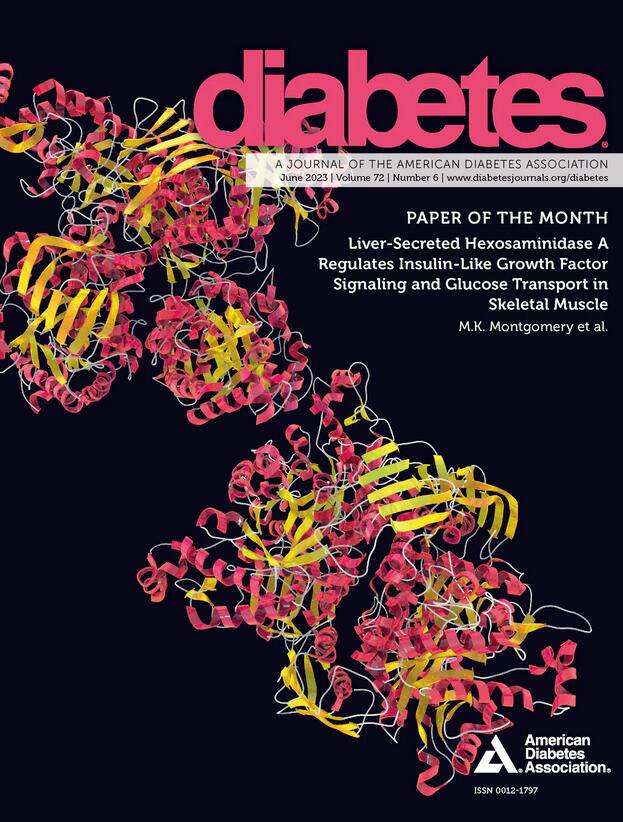巨噬细胞表达的微肽Smim30维持脂肪组织胰岛素敏感性和保障全身代谢稳态
IF 7.5
1区 医学
Q1 ENDOCRINOLOGY & METABOLISM
引用次数: 0
摘要
近年来,越来越多的微肽(miPs)被发现,但它们的生物学作用在很大程度上仍未被探索。我们确定了一个保守的6 kda miP,称为小积分膜蛋白30 (SMIM30),作为一个潜在的代谢调节因子。为了研究Smim30的生理功能,我们使用CRISPR/ cas9介导的敲入策略产生了一个功能缺失的小鼠品系。当喂食正常食物和高脂肪食物时,这些老鼠表现出血糖和胰岛素水平升高,胰岛素敏感性降低。我们进一步表明,脂肪组织中Smim30的缺失驱动了全身性胰岛素抵抗,尽管有趣的是,脂肪细胞表达的Smim30在这一作用中是不可或缺的。相反,Smim30主要在脂肪组织巨噬细胞中表达,Smim30的缺失导致巨噬细胞浸润增加,促炎细胞因子和趋化因子的产生增加。Smim30还可以调节体外/体外巨噬细胞系统的炎症反应,这在人和小鼠中都是保守的。结果表明,Smim30在维持脂肪组织胰岛素敏感性和保护全身代谢稳态方面发挥关键作用,具有作为代谢紊乱的诊断生物标志物和治疗靶点的潜力。了解微肽(miPs)在代谢调节中的作用可以增强对代谢性疾病的认识,并为治疗开辟新的途径。小积分膜蛋白30 (Smim30)是一种脂肪组织巨噬细胞表达的miP,维持胰岛素敏感性和保障全身代谢稳态。Smim30调节脂肪组织中的炎症反应和巨噬细胞-脂肪细胞通讯。Smim30可作为代谢性疾病的潜在诊断生物标志物和治疗靶点。本文章由计算机程序翻译,如有差异,请以英文原文为准。
Macrophage-Expressed Micropeptide Smim30 Maintains Adipose Tissue Insulin Sensitivity and Safeguards Systemic Metabolic Homeostasis
A growing number of micropeptides (miPs) have been identified in recent years, but their biological roles remain largely unexplored. We identified a conserved 6-kDa miP, named small integral membrane protein 30 (SMIM30), as a potential metabolic regulator. To study the physiological function of Smim30, we generated a loss-of-function mouse strain using the CRISPR/Cas9-mediated knock-in strategy. When fed both normal chow and high-fat diets, these mice exhibited elevated blood glucose and insulin levels, with reduced insulin sensitivity. We further showed that Smim30 loss in adipose tissue drove systemic insulin resistance, although intriguingly, adipocyte-expressed Smim30 was dispensable in this effect. Instead, Smim30 was mainly expressed in adipose tissue–residential macrophages, and loss of Smim30 led to increased macrophage infiltration and production of proinflammatory cytokines and chemokines. Smim30 also modulated inflammatory responses in ex vivo/in vitro macrophage systems, which are conserved in both humans and mice. The results indicate that Smim30 plays a key role in maintaining adipose tissue insulin sensitivity and safeguarding systemic metabolic homeostasis, offering potential as both a diagnostic biomarker and therapeutic target for metabolic disorders. Article Highlights Understanding the role of micropeptides (miPs) in metabolic regulation could enhance insights into metabolic diseases and open new pathways for treatment. Small integral membrane protein 30 (Smim30), an adipose tissue macrophage–expressed miP, maintains insulin sensitivity and safeguards systemic metabolic homeostasis. Smim30 modulates inflammatory responses and macrophage–adipocyte communication in adipose tissue. Smim30 could serve as a potential diagnostic biomarker and therapeutic target for metabolic disorders.
求助全文
通过发布文献求助,成功后即可免费获取论文全文。
去求助
来源期刊

Diabetes
医学-内分泌学与代谢
CiteScore
12.50
自引率
2.60%
发文量
1968
审稿时长
1 months
期刊介绍:
Diabetes is a scientific journal that publishes original research exploring the physiological and pathophysiological aspects of diabetes mellitus. We encourage submissions of manuscripts pertaining to laboratory, animal, or human research, covering a wide range of topics. Our primary focus is on investigative reports investigating various aspects such as the development and progression of diabetes, along with its associated complications. We also welcome studies delving into normal and pathological pancreatic islet function and intermediary metabolism, as well as exploring the mechanisms of drug and hormone action from a pharmacological perspective. Additionally, we encourage submissions that delve into the biochemical and molecular aspects of both normal and abnormal biological processes.
However, it is important to note that we do not publish studies relating to diabetes education or the application of accepted therapeutic and diagnostic approaches to patients with diabetes mellitus. Our aim is to provide a platform for research that contributes to advancing our understanding of the underlying mechanisms and processes of diabetes.
 求助内容:
求助内容: 应助结果提醒方式:
应助结果提醒方式:


